Between 30 and 40 students and faculty attended the discussion. Each attendee was given a blank piece of paper and a pencil and asked to write down responses to five works of photography and art that were projected on a screen in the front of the room. The anonymous responses were read aloud, and students and faculty voiced their opinions about the works. The conversation was then steered toward visual humor on campus and in American media, particularly that which can be viewed as racist or sexist. Corresponding examples were projected on the screen.
The majority of the works of visual humor presented at the beginning of the discussion lacked one essential element: humor. Suspecting this reaction, one of the organizers of the event clarified that humor doesn't necessarily prompt laughter or the idea that something is funny, which begs the question, what is humor? I understand that a work doesn't have to induce laughter to qualify as visual humor, but I was reasonably certain that it had to do more than evoke confusion, and I think Merriam-Webster's Dictionary might side with me on this one.
Yet, that was the least of the event's problems. A discussion devoted to bringing to light the implications of hurtful visual representations is certainly one that needs to be had. The problem is that when everyone has the same viewpoint, the discussion just turns into a means for people to wax pedantic and nod their heads at self-affirming opinions.
Instead of discovering and developing a new perspective on the subject by assimilating fresh or opposing outlooks, it seemed like everyone only became more steadfast in their beliefs, which isn't necessarily a bad thing considering those beliefs essentially were that racism in visual work is bad.
"There was no one to counter what we were saying," said Terra Branson '10, who described the discussion group as "self-selective."
I noticed a number of the students in attendance seemed particularly informed about some of the works of art and photography, and some of the ideas and phrases they put forth were noticeably similar. Apparently, a portion of the students were all in the same Native American studies class, in which the works presented at the discussion were already analyzed and the conversation in progress had already been had.
"I think we kind of cheated because we already talked about this," said Cinnamon Spear '09, who was encouraged by her professor to attend.
The discussion was just a rehashing of ones in class by students who already knew what to say. Upon learning this, I have to say I felt deceived. I was an outsider who was disadvantaged by a dearth of knowledge that others had already gained. Had I not been placated by the Panera lunch that was provided and the solace in knowing I had saved a few bucks of DBA, you can be sure my protest would have been heard loud and clear.
Towards the end, the topic of discussion moved to the need to have discussions such as the one in progress and ways to reach out to students who wouldn't come to such forums on their own. This at least demonstrated an understanding that the attendees shared the same mindset and that a truly useful discussion would include students who didn't agree with what was being said. However, I didn't think these self-calls needed to last 20 minutes, and the assumption that everyone agreed, though correct, gave the group a cultish missionary vibe. Then again, maybe I'm just being overly critical of a group of people who believe in the same principles, and who have unanimously decided to propagate these ideas and instill them in unsuspecting minds.
Despite the faults, the analysis of art and images pertaining to issues of race and gender was intelligent and interesting. I do believe that calling out potentially harmful visual material is a necessary conversation to have, but the homogeny of the opinions about the idea of "whiteness" that dominates many standards in Western culture and can lead to racism in visual work has an irony that was certainly not lost on me.




